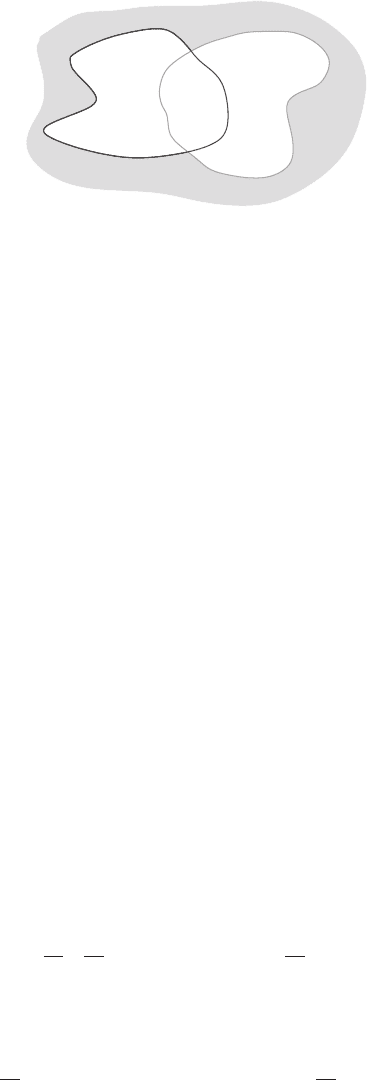Stone M., Goldbart P. Mathematics for Physics: A Guided Tour for Graduate Students
Подождите немного. Документ загружается.


17.4 Applications of Cauchy’s theorem 635
Morera’s theorem
There is a partial converse of Cauchy’s theorem:
Theorem (Morera): If f (z) is defined and continuous in a domain D, and if
E
f (z ) dz =
0 for all closed contours, then f (z) is analytic in D.
To prove this we set F(z) =
z
P
f (ζ ) dζ . The integral is path-independent by the hypoth-
esis of the theorem, and because f (z) is continuous we can differentiate with respect to
the integration limit to find that F
(z) = f (z). Thus F(z) is complex differentiable, and
so analytic. Then, by Cauchy’s formula for higher derivatives, F
(z) = f
(z) exists, and
so f (z) itself is analytic.
A corollary of Morera’s theorem is that if f
n
(z) → f (z) uniformly in D, with all the f
n
analytic, then
(i) f (z) is analytic in D, and
(ii) f
n
(z) → f
(z) uniformly.
We use Morera’s theorem to prove (i) (appealing to the uniform convergence to justify
the interchange of the order of summation and integration), and use Cauchy’s theorem
to prove (ii).
Taylor’s theorem for analytic functions
Theorem: Let be a circle of radius ρ centred on the point a. Suppose that f (z) is
analytic within and on , and that the point z = ζ is within . Then f (ζ ) can be
expanded as a Taylor series
f (ζ ) = f (a) +
∞
n=1
(ζ − a)
n
n!
f
(n)
(a), (17.111)
meaning that this series converges to f (ζ ) for all ζ such that |ζ − a| <ρ.
To prove this theorem we use the identity
1
z − ζ
=
1
z − a
+
(ζ − a)
(z − a)
2
+···+
(ζ − a)
N −1
(z − a)
N
+
(ζ − a)
N
(z − a)
N
1
z − ζ
(17.112)
and Cauchy’s integral, to write
f (ζ ) =
1
2πi
F
f (z )
(z − ζ)
dz
=
N −1
n=0
(ζ − a)
n
2πi
F
f (z )
(z − a)
n+1
dz +
(ζ − a)
N
2πi
F
f (z )
(z − a)
N
(z − ζ)
dz
=
N −1
n=0
(ζ − a)
n
n!
f
(n)
(a) + R
N
, (17.113)

636 17 Complex analysis
where
R
N
def
=
(ζ − a)
N
2πi
F
f (z )
(z − a)
N
(z − ζ)
dz. (17.114)
This is Taylor’s theorem with remainder. For real variables this is as far as we can go.
Even if a real function is differentiable infinitely many times, there is no reason for the
remainder to become small. For analytic functions, however, we can show that R
N
→ 0
as N →∞. This means that the complex-variable Taylor series is convergent, and its
limit is actually equal to f (z). To show that R
N
→ 0, recall that is a circle of radius
ρ centred on z = a. Let r =|ζ − a| <ρ, and let M be an upper bound for f (z) on .
(This exists because f is continuous and is a compact subset of C.) Then, estimating
the integral using methods similar to those invoked in our proof of Liouville’s theorem,
we find that
R
N
<
r
N
2π
2πρM
ρ
N
(ρ − r)
. (17.115)
As r <ρ, this tends to zero as N →∞.
We can take ρ as large as we like provided there are no singularities of f that end up
within, or on, the circle. This confirms the claim made earlier: the radius of convergence
of the power series representation of an analytic function is the distance to the nearest
singularity.
Laurent series
Theorem (Laurent): Let
1
and
2
be two anticlockwise circlular paths with centre a,
radii ρ
1
and ρ
2
and with ρ
2
<ρ
1
(see Figure 17.11). If f (z) is analytic on the circles
2
1
a
Figure 17.11 Contours for Laurent’s theorem.

17.4 Applications of Cauchy’s theorem 637
and within the annulus between them, then, for ζ in the annulus:
f (ζ ) =
∞
n=0
a
n
(ζ − a)
n
+
∞
n=1
b
n
(ζ − a)
−n
. (17.116)
The coefficients a
n
and b
n
are given by
a
n
=
1
2πi
F
1
f (z )
(z − a)
n+1
dz, b
n
=
1
2πi
F
2
f (z )(z − a)
n−1
dz. (17.117)
Laurent’s theorem is proved by observing that
f (ζ ) =
1
2πi
F
1
f (z )
(z − ζ)
dz −
1
2πi
F
2
f (z )
(z − ζ)
dz, (17.118)
and using the identities
1
z − ζ
=
1
z − a
+
(ζ − a)
(z − a)
2
+···+
(ζ − a)
N −1
(z − a)
N
+
(ζ − a)
N
(z − a)
N
1
z − ζ
, (17.119)
and
−
1
z − ζ
=
1
ζ − a
+
(z − a)
(ζ − a)
2
+···+
(z − a)
N −1
(ζ − a)
N
+
(z − a)
N
(ζ − a)
N
1
ζ − z
. (17.120)
Once again we can show that the remainder terms tend to zero.
Warning: Although the coefficients a
n
are given by the same integrals as in Taylor’s
theorem, they are not interpretable as derivatives of f unless f (z) is analytic within the
inner circle, in which case all the b
n
are zero.
17.4.3 Zeros and singularities
This section is something of a nosology – a classification of diseases – but you should
study it carefully as there is some tight reasoning here, and the conclusions are the
essential foundations for the rest of subject.
First a review and some definitions:
(a) If f (z) is analytic with a domain D, we have seen that f may be expanded in a Taylor
series about any point z
0
∈ D:
f (z ) =
∞
n=0
a
n
(z − z
0
)
n
. (17.121)
If a
0
= a
1
=··· =a
n−1
= 0, and a
n
= 0, so that the first non-zero term in the
series is a
n
(z − z
0
)
n
, we say that f (z) has a zero of order n at z
0
.
638 17 Complex analysis
(b) A singularity of f (z) is a point at which f (z) ceases to be differentiable. If f (z) has
no singularities at finite z (for example, f (z) = sin z) then it is said to be an entire
function.
(c) If f (z) is analytic in D except at z = a,anisolated singularity, then we may draw
two concentric circles of centre a, both within D, and in the annulus between them
we have the Laurent expansion
f (z ) =
∞
n=0
a
n
(z − a)
n
+
∞
n=1
b
n
(z − a)
−n
. (17.122)
The second term, consisting of negative powers, is called the principal part of f (z)
at z = a. It may happen that b
m
= 0 but b
n
= 0, n > m. Such a singularity is
called a pole of order m at z = a. The coefficient b
1
, which may be 0, is called the
residue of f at the pole z = a. If the series of negative powers does not terminate,
the singularity is called an isolated essential singularity.
Now some observations:
(i) Suppose f (z) is analytic in a domain D containing the point z = a. Then we can
expand: f (z) =
,
a
n
(z − a)
n
.Iff (z) is zero at z = 0, then there are exactly two
possibilities: (a) all the a
n
vanish, and then f (z) is identically zero; (b) there is a
first non-zero coefficient, a
m
say, and so f (z) = z
m
ϕ(z), where ϕ(a) = 0. In the
second case f is said to possess a zero of order m at z = a.
(ii) If z = a is a zero of order m of f (z) then the zero is isolated – i.e. there is a
neighbourhood of a which contains no other zero. To see this observe that f (z) =
(z − a)
m
ϕ(z) where ϕ(z) is analytic and ϕ(a) = 0. Analyticity implies continuity,
and by continuity there is a neighbourhood of a in which ϕ(z) does not vanish.
(iii) Limit points of zeros I: Suppose that we know that f (z) is analytic in D and we
know that it vanishes at a sequence of points a
1
, a
2
, a
3
, ... ∈ D. If these points have
a limit point
6
that is interior to D then f (z) must, by continuity, be zero there. But
this would be a non-isolated zero, in contradiction to item (ii), unless f (z) actually
vanishes identically in D. This, then, is the only option.
(iv) From the definition of poles, they too are isolated.
(v) If f (z) has a pole at z = a then f (z) →∞as z → a in any manner.
(vi) Limit points of zeros II: Suppose we know that f is analytic in D, except possibly
at z = a which is a limit point of zeros as in (iii), but we also know that f is not
identically zero. Then z = a must be a singularity of f – but not a pole (because
f would tend to infinity and could not have arbitrarily close zeros) – so a must
be an isolated essential singularity. For example, sin 1/z has an isolated essential
singularity at z = 0, this being a limit point of the zeros at z = 1/nπ.
(vii) A limit point of poles or other singularities would be a non-isolated essential
singularity .
6
A point z
0
is a limit point of a set S if for every >0 there is some a ∈ S, other than z
0
itself, such that
|a − z
0
|≤. A sequence need not have a limit for it to possess one or more limit points.

17.4 Applications of Cauchy’s theorem 639
D
1
D
2
Figure 17.12 Intersecting domains.
17.4.4 Analytic continuation
Suppose that f
1
(z) is analytic in the (open, arcwise-connected) domain D
1
, and f
2
(z) is
analytic in D
2
, with D
1
∩ D
2
=∅(Figure 17.12). Suppose further that f
1
(z) = f
2
(z)
in D
1
∩ D
2
. Then we say that f
2
is an analytic continuation of f
1
to D
2
. Such analytic
continuations are unique:iff
3
is also analytic in D
2
, and f
3
= f
1
in D
1
∩ D
2
, then
f
2
− f
3
= 0inD
1
∩ D
2
. Because the intersection of two open sets is also open, f
1
− f
2
vanishes on an open set and so by observation (iii) of the previous section, it vanishes
everywhere in D
2
.
We can use this uniqueness result, coupled with the circular domains of convergence
of the Taylor series, to extend the definition of analytic functions beyond the domain of
their initial definition.
The distribution x
α−1
+
An interesting and useful example of analytic continuation is provided by the distribution
x
α−1
+
, which, for real positive α, is defined by its evaluation on a test function ϕ(x) as
(x
α−1
+
, ϕ) =
∞
0
x
α−1
ϕ(x) dx. (17.123)
The pairing (x
α−1
+
, ϕ) extends to a complex analytic function of α provided the integral
converges. Test functions are required to decrease at infinity faster than any power of
x, and so the integral always converges at the upper limit. It will converge at the lower
limit provided Re (α) > 0. Assume that this is so, and integrate by parts using
d
dx
x
α
α
ϕ(x)
= x
α−1
ϕ(x) +
x
α
α
ϕ
(x). (17.124)
We find that, for >0,
x
α
α
ϕ(x)
∞
=
∞
x
α−1
ϕ(x) dx +
∞
x
α
α
ϕ
(x) dx. (17.125)

640 17 Complex analysis
The integrated-out part on the left-hand side of (17.125) tends to zero as we take to
zero, and both of the integrals converge in this limit as well. Consequently
I
1
(α) ≡−
1
α
∞
0
x
α
ϕ
(x) dx (17.126)
is equal to (x
α−1
+
, ϕ) for 0 < Re (α) < ∞. However, the integral defining I
1
(α)
converges in the larger region −1 < Re (α) < ∞. It therefore provides an analytic con-
tinuation to this larger domain. The factor of 1/α reveals that the analytically continued
function possesses a pole at α = 0, with residue
−
∞
0
ϕ
(x) dx = ϕ(0). (17.127)
We can repeat the integration by parts, and find that
I
2
(α) ≡
1
α(α + 1)
∞
0
x
α+1
ϕ
(x) dx (17.128)
provides an analytic continuation to the region −2 < Re (α) < ∞. By proceeding in
this manner, we can continue (x
α−1
+
, ϕ) to a function analytic in the entire complex α
plane with the exception of zero and the negative integers, at which it has simple poles.
The residue of the pole at α =−n is ϕ
(n)
(0)/n!.
There is another, much more revealing, way of expressing these analytic continuations.
To obtain this, suppose that φ ∈ C
∞
[0, ∞] and φ → 0 at infinity as least as fast as 1/x.
(Our test function ϕ decreases much more rapidly than this, but 1/x is all we need for
what follows.) Now the function
I(α) ≡
∞
0
x
α−1
φ(x) dx (17.129)
is convergent and analytic in the strip 0 < Re (α) < 1. By the same reasoning as above,
I(α) is there equal to
−
∞
0
x
α
α
φ
(x) dx. (17.130)
Again this new integral provides an analytic continuation to the larger strip −1 <
Re (α) < 1. But in the left-hand half of this strip, where −1 < Re (α) < 0, we

17.4 Applications of Cauchy’s theorem 641
can write
−
∞
0
x
α
α
φ
(x) dx = lim
→0
∞
x
α−1
φ(x) dx −
x
α
α
φ(x)
∞
= lim
→0
∞
x
α−1
φ(x) dx + φ()
α
α
= lim
→0
∞
x
α−1
[φ(x) − φ()]dx
,
=
∞
0
x
α−1
[φ(x) − φ(0)]dx. (17.131)
Observe how the integrated out part, which tends to zero in 0 < Re (α) < 1, becomes
divergent in the strip −1 < Re (α) < 0. This divergence is there craftily combined with
the integral to cancel its divergence, leaving a finite remainder. As a consequence, for
−1 < Re (α) < 0, the analytic continuation is given by
I(α) =
∞
0
x
α−1
[φ(x) − φ(0)]dx. (17.132)
Next we observe that χ(x) =[φ(x) − φ(0)]/x tends to zero as 1/x for large x, and
at x = 0 can be defined by its limit as χ(0) = φ
(0). This χ(x) then satisfies the same
hypotheses as φ(x). With I(α) denoting the analytic continuation of the original I,we
therefore have
I(α) =
∞
0
x
α−1
[φ(x) − φ(0)]dx, −1 < Re (α) < 0
=
∞
0
x
β−1
φ(x) − φ(0)
x
dx, where β = α + 1
→
∞
0
x
β−1
φ(x) − φ(0)
x
− φ
(0)
dx, −1 < Re (β) < 0
=
∞
0
x
α−1
[φ(x) − φ(0) − xφ
(0)]dx, −2 < Re (α) < −1, (17.133)
the arrow denoting the same analytic continuation process that we used with φ.
We can now apply this machinery to our original ϕ(x), and so deduce that the
analytically continued distribution is given by
(x
α−1
+
, ϕ) =
⎧
⎪
⎪
⎪
⎪
⎪
⎪
⎪
⎨
⎪
⎪
⎪
⎪
⎪
⎪
⎪
⎩
∞
0
x
α−1
ϕ(x) dx,0< Re (α) < ∞
∞
0
x
α−1
[ϕ(x) − ϕ(0)]dx, −1 < Re (α) < 0
∞
0
x
α−1
[ϕ(x) − ϕ(0) − xϕ
(0)]dx, −2 < Re (α) < −1,
(17.134)

642 17 Complex analysis
and so on. The analytic continuation automatically subtracts more and more terms of the
Taylor series of ϕ(x) the deeper we penetrate into the left-hand half-plane. This property,
that analytic continuation covertly subtracts the minimal number of Taylor-series terms
required to ensure convergence, lies behind a number of physics applications, most
notably the method of dimensional regularization in quantum field theory.
The following exercise illustrates some standard techniques of reasoning via analytic
continuation.
Exercise 17.8: Define the dilogarithm function by the series
Li
2
(z) =
z
1
2
+
z
2
2
2
+
z
3
3
2
+···.
The radius of convergence of this series is unity, but the domain of Li
2
(z) can be extended
to |z| > 1 by analytic continuation.
(a) Observe that the series converges at z =±1, and at z = 1is
Li
2
(1) = 1 +
1
2
2
+
1
3
2
+···=
π
2
6
.
Rearrange the series to show that
Li
2
(−1) =−
π
2
12
.
(b) Identify the derivative of the power series for Li
2
(z) with that of an elementary
function. Exploit your identification to extend the definition of [Li
2
(z)]
outside
|z| < 1. Use the properties of this derivative function, together with part (a), to
prove that the extended function obeys
Li
2
(−z) + Li
2
−
1
z
=−
1
2
(ln z)
2
−
π
2
6
.
This formula allows us to calculate values of the dilogarithm for |z| > 1 in terms of
those with |z| < 1.
Many weird identities involving dilogarithms exist. Some, such as
Li
2
−
1
2
+
1
6
Li
2
1
9
=−
1
18
π
2
+ ln 2 ln 3 −
1
2
(ln 2)
2
−
1
3
(ln 3)
2
,
were found by Ramanujan. Others, originally discovered by sophisticated numeri-
cal methods, have been given proofs based on techniques from quantum mechanics.
Polylogarithms, defined by
Li
k
(z) =
z
1
k
+
z
2
2
k
+
z
3
3
k
+···,
occur frequently when evaluating Feynman diagrams.

17.4 Applications of Cauchy’s theorem 643
17.4.5 Removable singularities and the Weierstrass–Casorati theorem
Sometimes we are given a definition that makes a function analytic in a region with the
exception of a single point. Can we extend the definition to make the function analytic
in the entire region? Provided that the function is well enough behaved near the point,
the answer is yes, and the extension is unique. Curiously, the proof that this is so gives
us insight into the wild behaviour of functions near essential singularities.
Removable singularities
Suppose that f (z) is analytic in D \ a, but that lim
z→a
(z − a)f (z) = 0. Then f may be
extended to a function analytic in all of D, i.e. z = a is a removable singularity. To see
this, let ζ lie between two simple closed contours
1
and
2
, with a within the smaller,
2
. We use Cauchy to write
f (ζ ) =
1
2πi
F
1
f (z )
z − ζ
dz −
1
2πi
F
2
f (z )
z − ζ
dz. (17.135)
Now we can shrink
2
down to be very close to a, and because of the condition on f (z)
near z = a, we see that the second integral vanishes. We can also arrange for
1
to
enclose any chosen point in D. Thus, if we set
˜
f (ζ ) =
1
2πi
F
1
f (z )
z − ζ
dz (17.136)
within
1
, we see that
˜
f = f in D \a, and is analytic in all of D. The extension is unique
because any two analytic functions that agree everywhere except for a single point, must
also agree at that point.
Weierstrass–Casorati theorem
We apply the idea of removable singularities to show just how pathological a beast is an
isolated essential singularity:
Theorem (Weierstrass–Casorati): Let z = a be an isolated essential singularity of f (z).
Then in any neighbourhood of a, the function f (z) comes arbitrarily close to any assigned
values in C.
To prove this, define N
δ
(a) ={z ∈ C : |z−a| <δ}, and N
(ζ ) ={z ∈ C : |z−ζ | <}.
The claim is then that there is an z ∈ N
δ
(a) such that f (z ) ∈ N
(ζ ). Suppose that the
claim is not true. Then we have |f (z) − ζ | >for all z ∈ N
δ
(a). Therefore
!
!
!
!
1
f (z ) − ζ
!
!
!
!
<
1
(17.137)
in N
δ
(a), while 1/(f (z) − ζ) is analytic in N
δ
(a) \ a. Therefore z = a is a removable
singularity of 1/(f (z)−ζ), and there is an analytic g(z) which coincides with 1/(f (z)−ζ)

644 17 Complex analysis
at all points except a. Therefore
f (z ) = ζ +
1
g(z)
(17.138)
except at a. Now g(z), being analytic, may have a zero at z = a giving a pole in f , but
it cannot give rise to an essential singularity. The claim is true, therefore.
Picard’s theorems
The Weierstrass–Casorati theorem is elementary. There are much stronger results:
Theorem (Picard’s little theorem): Every non-constant entire function attains every
complex value with at most one exception.
Theorem (Picard’s big theorem): In any neighbourhood of an isolated essential
singularity, f (z) takes every complex value with at most one exception.
The proofs of these theorems are hard.
As an illustration of Picard’s little theorem, observe that the function exp z is entire, and
takes all values except 0. For the big theorem observe that the function f (z) = exp(1/z)
has an essential singularity at z = 0, and takes all values, with the exception of 0, in any
neighbourhood of z = 0.
17.5 Meromorphic functions and the winding number
Afunction whose only singularities in D are poles is said to be meromorphic there. These
functions have a number of properties that are essentially topological in character.
17.5.1 Principle of the argument
If f (z) is meromorphic in D with ∂D = , and f (z) = 0on, then
1
2πi
F
f
(z)
f (z )
dz = N −P (17.139)
where N is the number of zeros in D and P is the number of poles. To show this, we note
that if f (z) = (z − a)
m
ϕ(z) where ϕ is analytic and non-zero near a, then
f
(z)
f (z )
=
m
z − a
+
ϕ
(z)
ϕ(z)
(17.140)
so f
/f has a simple pole at a with residue m. Here m can be either positive or negative.
The term ϕ
(z)/ϕ(z) is analytic at z = a, so collecting all the residues from each zero or
pole gives the result.
